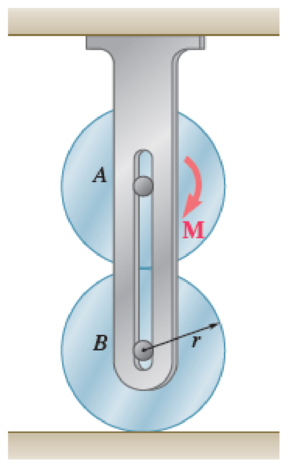
Concept explainers
Two identical uniform cylinders of mass m and radius r are at rest at time t = 0 when a couple M of constant magnitude M < mgr is applied to cylinder A. Knowing that the coefficient of kinetic friction between cylinder B and the horizontal surface is

Fig. P17.62 and P17.63
Want to see the full answer?
Check out a sample textbook solution
Chapter 17 Solutions
Vector Mechanics for Engineers: Statics and Dynamics
Additional Engineering Textbook Solutions
Engineering Mechanics: Dynamics (14th Edition)
Vector Mechanics for Engineers: Statics, 11th Edition
Shigley's Mechanical Engineering Design (McGraw-Hill Series in Mechanical Engineering)
Vector Mechanics for Engineers: Statics
Introduction to Heat Transfer
Engineering Mechanics: Statics & Dynamics (14th Edition)
- The 200-mm-radius brake drum is attached to a larger Bywheel. The total mass moment of inertia of the flywheel and drum is 19 kg. and the coefficient of kinetic friction between the drum and the brake shoe is 035, Knowing that the initial angular velocity of the flywheel is 180 rpm clockwise, determine the vertical force P that must be applied to the pedal C if the system is to stop in 100 revolutions. 150 mm 250 mm B ne: P= 172.88 N C 375 mm 200 mmarrow_forwardThe mechanism shown is one of two identical mechanisms attached to the two sides of a 180-lb uniform rectangular door. Edge ABC of the door is guided by wheels of negligible mass that roll in horizontal and vertical tracks. A spring of constant k is attached to wheel Bin such a way that its tension is zero when 0 = 30°. Knowing that the door is released from rest in the position 0 = 45° and reaches the vertical position with an angular velocity of 0.6 rad/s, determine the spring constant k. 5 ft 5 ft The spring constant is Ib/ft.arrow_forwardThe 12-lb uniform disk shown has a radius of r = 3.2 in. and rotates counterclockwise. Its center C is constrained to move in a slot cut in the vertical member AB, and an 11-lb horizontal force P is applied at B to maintain contact at D between the disk and the vertical wall. The disk moves downward under the influence of gravity and the friction at D. Knowing that the coefficient of kinetic friction between the disk and the wall is 0.12 and neglecting friction in the vertical slot, determine (a) the angular acceleration of the disk, (b) the acceleration of the center C of the disk.arrow_forward
- A uniform 144-lb cube is attached to a uniform 136-lb circular shaft as shown, and a couple M with a constant magnitude is applied to the shaft when the system is at rest. Knowing that r = 4 in., L= 12 in., and the angular velocity of the system is 960 rpm after 4 s, determine the magnitude of the couple M.arrow_forwardEnd A of the 8-kg uniform rod AB is attached to a collar that can slide without friction on a vertical rod. End B of the rod is attached to a ver- tical cable BC. If the rod is released from rest in the position shown, determine immediately after release (a) the angular acceleration of the rod, (b) the reaction at A. Please show clear diagrams.arrow_forward3. The 10-in.-radius brake drum is attached to A a larger flywheel which is not shown. The total mass moment of inertia of the flywheel and drum is 16 lb · ft · s² and the coefficient of kinetic 6 in. friction between the drum and the brake shoe is В 0.40. Knowing that the initial angular velocity is 240 rpm clockwise, determine the force which must be exerted by the hydraulic cylinder if the system is to stop in 75 revolutions. 12 in. D Use work-energy equation. 10 in. +6 in.-arrow_forward
- A bar of mass m = 5 kg is held as shown between four disks each of mass m’ = 2 kg and radius r = 75 mm. Knowing that the forces exerted on the disks are sufficient to prevent slipping and that the bar is released from rest, for each of the cases shown, determine the velocity of the bar after it has moved through the distance h.arrow_forwardThe double pulley shown has a weight of 35.0 lb and a centroidal radius of gyration of 5.0 in. Cylinder A (25.0 lb) and block B (16 lb) are attached to cords that wrap around pulleys in the manner shown. The coefficient of kinetic friction between block B and the surface is 0.25. Knowing that the system is released from rest at the position shown (h = 4 ft), determine the velocity of cylinder A when it strikes the ground. 6 in. A h 10 in. Barrow_forwardQuestion 4: The brake drum of radius 10 cm is attached is a larger flywheel that is not shown. The total mass moment of inertia of the drum and the flywheel is 50 kg.cm? and the coefficient of kinetic friction between the drum and the brake shoe is 0.35. Knowing that the angular velocity of the flywheel is 360 rpm counterclockwise when a force P of magnitude 40 N is applied to the pedal C, determine the number of revolutions executed by the flywheel before it comes to rest. 15 сm |A 25 cm D 10 cm 35 cm-arrow_forward
- . 16.23 A 20-lb uniform disk is placed in contact with an inclined surface and a constant 7.5 lb ft couple M is applied as shown. The weight of the link AB is negligible. Knowing that the coefficient of kinetic friction at D is 0.4, de- termine (a) the angular acceleration of the disk, (b) the force in the link AB. 9 in Fig. P16.23 and P16.24 Darrow_forwardA 40-kg flywheel of radius R = 0.5 m is rigidly attached to a shaft of radius r = 0.05 m that can roll along parallel rails. A cord is attached as shown and pulled with a force P of magnitude 150 N. Knowing the centroidal radius of gyration is k = 0.4 m, determine (a) the angular acceleration of the flywheel, (b) the velocity of the center of gravity after 5 s. 15° Parrow_forwardThe mechanism shown is one of two identical mechanisms attached to the two sides of a 200-lb uniform rectangular door. Edge ABC of the door is guided by wheels of negligible mass that roll in horizontal and vertical tracks. A spring with a constant k is attached to wheel B in such a way that its tension is zero when 0 = 30°, Knowing that the door is released from rest in the position 0 = 45° and reaches the vertical position with an angular velocity of 0.6 rad/s, determine the spring constant k.arrow_forward
 Elements Of ElectromagneticsMechanical EngineeringISBN:9780190698614Author:Sadiku, Matthew N. O.Publisher:Oxford University Press
Elements Of ElectromagneticsMechanical EngineeringISBN:9780190698614Author:Sadiku, Matthew N. O.Publisher:Oxford University Press Mechanics of Materials (10th Edition)Mechanical EngineeringISBN:9780134319650Author:Russell C. HibbelerPublisher:PEARSON
Mechanics of Materials (10th Edition)Mechanical EngineeringISBN:9780134319650Author:Russell C. HibbelerPublisher:PEARSON Thermodynamics: An Engineering ApproachMechanical EngineeringISBN:9781259822674Author:Yunus A. Cengel Dr., Michael A. BolesPublisher:McGraw-Hill Education
Thermodynamics: An Engineering ApproachMechanical EngineeringISBN:9781259822674Author:Yunus A. Cengel Dr., Michael A. BolesPublisher:McGraw-Hill Education Control Systems EngineeringMechanical EngineeringISBN:9781118170519Author:Norman S. NisePublisher:WILEY
Control Systems EngineeringMechanical EngineeringISBN:9781118170519Author:Norman S. NisePublisher:WILEY Mechanics of Materials (MindTap Course List)Mechanical EngineeringISBN:9781337093347Author:Barry J. Goodno, James M. GerePublisher:Cengage Learning
Mechanics of Materials (MindTap Course List)Mechanical EngineeringISBN:9781337093347Author:Barry J. Goodno, James M. GerePublisher:Cengage Learning Engineering Mechanics: StaticsMechanical EngineeringISBN:9781118807330Author:James L. Meriam, L. G. Kraige, J. N. BoltonPublisher:WILEY
Engineering Mechanics: StaticsMechanical EngineeringISBN:9781118807330Author:James L. Meriam, L. G. Kraige, J. N. BoltonPublisher:WILEY





